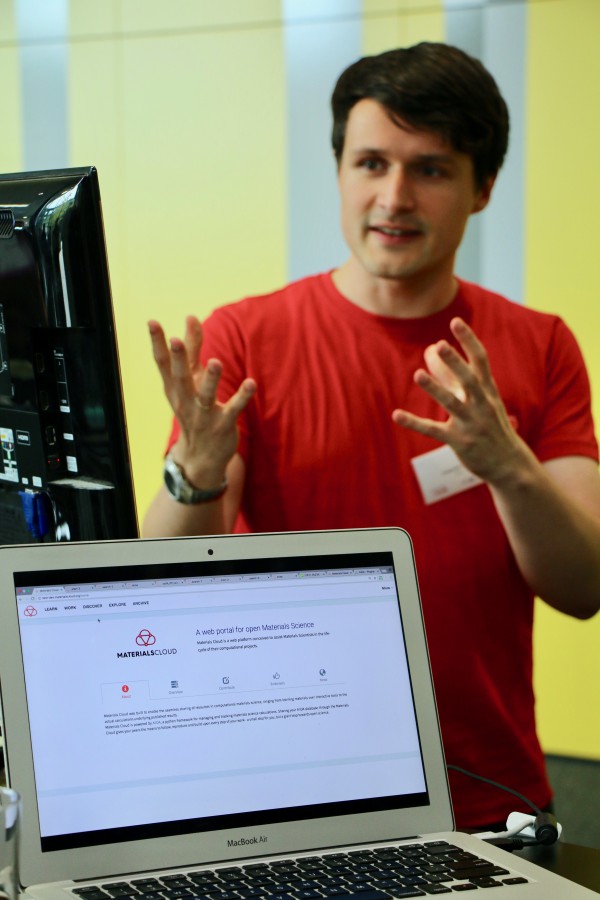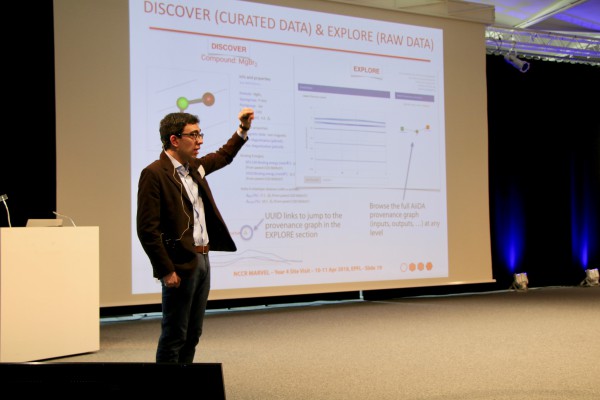Web platform “Materials Cloud” could help industry streamline research efforts
by Carey Sargent, EPFL, NCCR MARVEL

From a scientific point of view, we are strongly encouraging open science and open data, but of course we can fully understand and cover the case where it needs to be private. For example, if a company wants to use a service but doesn’t want to share the data, it can run the same software internally, privately in their network.
— Giovanni Pizzi, NCCR MARVEL scientist
With five sections—LEARN, WORK, DISCOVER, EXPLORE and ARCHIVE—the platform allows the seamless sharing of resources such as learning materials, interactive tools, virtual hardware, curated and raw data as well as the actual calculations underlying published results. While academic researchers are using it to render their scientific data complete, fully downloadable, easy to browse and ready to reuse, industrial partners are starting to use Materials Cloud to, for instance, keep track of, reproduce and visualize workflows. This may be just the beginning of industrial use of the tool.
“From a scientific point of view, we are strongly encouraging open science and open data, but of course we can fully understand and cover the case where it needs to be private,” said Giovanni Pizzi, an NCCR MARVEL scientist at EPFL who coordinates the Open Science platform of the project, which includes Materials Cloud. “For example, if a company wants to use a service but doesn’t want to share the data, it can run the same software internally, privately in their network.”
Materials Cloud offers advantages to any group looking to streamline and advance its research. Powered by AiiDA, a Python-based framework for managing and tracking materials science calculations, it allows you to share not only the results of your calculations but also every step taken to get there; to download individual files or entire databases with the click of a button; to browse and query calculations using a web browser, as well as download, import and use the databases of others.
In the midterm, we plan to make it possible to deploy the WORK section in other places— the automation scripts to do this are already in place and we will be looking for partners who might be interested in running Materials Cloud WORK on their own premises.
— Leopold Talirz, NCCR MARVEL scientist
The infrastructure was designed originally to provide a service useful to the academic community, but the developers see additional possibilities to expand collaborations with industry. One example is given by the site’s turnkey solutions. A combination of tools, simulation codes and data allow the user to simply upload a structure and get back its properties, such as the vibrational modes and spectra, without having to know how the codes are implemented or learn how to use them. Companies may be interested in having a version of Materials Cloud that hosts these turn-key solutions on their premises.
“Companies usually have very strict policies in terms of where their intellectual property can go and obviously they don’t want to use our cloud platform to run their workflows,” said Leopold Talirz, an NCCR MARVEL scientist at EPFL. “In the midterm, we plan to make it possible to deploy the WORK section in other places— the automation scripts to do this are already in place and we will be looking for partners who might be interested in running Materials Cloud WORK on their own premises.”
People who are interested in what this environment looks like can already get a taste of it using Quantum Mobile, a virtual machine that runs on Windows, MacOS and Linux. It contains Quantum ESPRESSO, CP2K, Siesta, Fleur, Yambo, and Wannier90, the most powerful, and popular open-source codes for performing materials simulations: they’re used in the writing of several thousands of papers every year. It also contains AiiDA and the same graphical interface as that seen on Materials Cloud. Quantum Mobile is open source, pre-built images can be downloaded from the Materials Cloud, and it can even be adapted to individual needs.

Leopold Talirz, NCCR MARVEL scientist
Typically, afterwards nobody knows anymore how to reproduce the calculation. Materials Cloud solves this problem. Moreover, what they get in addition is also a better way of visualizing the data and sharing it, either with the world or internally to collaborators.
— Leopold Talirz, NCCR MARVEL scientist
The infrastructure, including the tools and data currently on the platform, can also be used by groups with different scientific problems, the scientists said. Features such as tracking provenance, reproducibility and visualization tools could be applied to many other datasets.
“We haven’t limited what can be done to what we are interested in,” Talirz said.
One partner company is now using Materials Cloud to keep track of calculations in such a way that they’ll be able to easily reproduce them, say, two years from now. This is a big problem in academia because PhD students typically leave after a few years and take the knowledge of how to reproduce their calculations with them, but also for companies who may see staff turnover.
“Typically, afterwards nobody knows anymore how to reproduce the calculation,” Talirz said. “Materials Cloud solves this problem. Moreover, what they get in addition is also a better way of visualizing the data and sharing it, either with the world or internally to collaborators.“

Giovanni Pizzi presents Materials Cloud features at the 2018 MARVEL Site Visit.
I think that collaborations with industry will mainly start from scientific questions. In these cases, we will try to understand the needs and design a platform that can cover these uses. In practice there would be a specific research project between a group in MARVEL and a company that could make use of Materials Cloud.
— Giovanni Pizzi, NCCR MARVEL scientist
While in some cases the Materials Cloud team could act mainly as a service or software provider to industry, it could also act as a facilitator between companies with specific research or application needs and the NCCR MARVEL research group featuring experts in the given field. The Materials Cloud developers—who also include Snehal Kumbhar, Aliaksandr Yakutovich, Elsa Passaro and Marco Borelli—could in these cases put the company in contact with interested research groups of the NCCR MARVEL or of the other research partners, who can in turn develop the workflows or their interface for the specific needs of the company. This could be a simple matter of automation or could even be more involved, requiring developments of the theory.
“I think that collaborations with industry will mainly start from scientific questions,” Pizzi said. “In these cases, we will try to understand the needs and design a platform that can cover these uses. In practice there would be a specific research project between a group in MARVEL and a company that could make use of Materials Cloud.”
The developers will continue to add new content and new functionalities and welcome contributions from researchers affiliated with its scientific partners. All are welcome to explore the results and provide feedback at info@materialscloud.org.
Materials Cloud is supported by NCCR MARVEL, EPFL, and the European H2020 MaX project; research partners include the European H2020 NFFA, EMMC, and “MarketPlace” projects, as well as the supercomputing centers CSCS, CINECA, and Forschungszentrum Jülich.
Low-volume newsletters, targeted to the scientific and industrial communities.
Subscribe to our newsletter